【备课参考】(人教)高中英语必修5同步教学课件:Unit 1 Great scientists Workbook(共47张PPT)
文档属性
| 名称 | 【备课参考】(人教)高中英语必修5同步教学课件:Unit 1 Great scientists Workbook(共47张PPT) |  | |
| 格式 | zip | ||
| 文件大小 | 475.2KB | ||
| 资源类型 | 教案 | ||
| 版本资源 | 人教版(新课程标准) | ||
| 科目 | 英语 | ||
| 更新时间 | 2015-07-29 17:57:55 | ||
图片预览

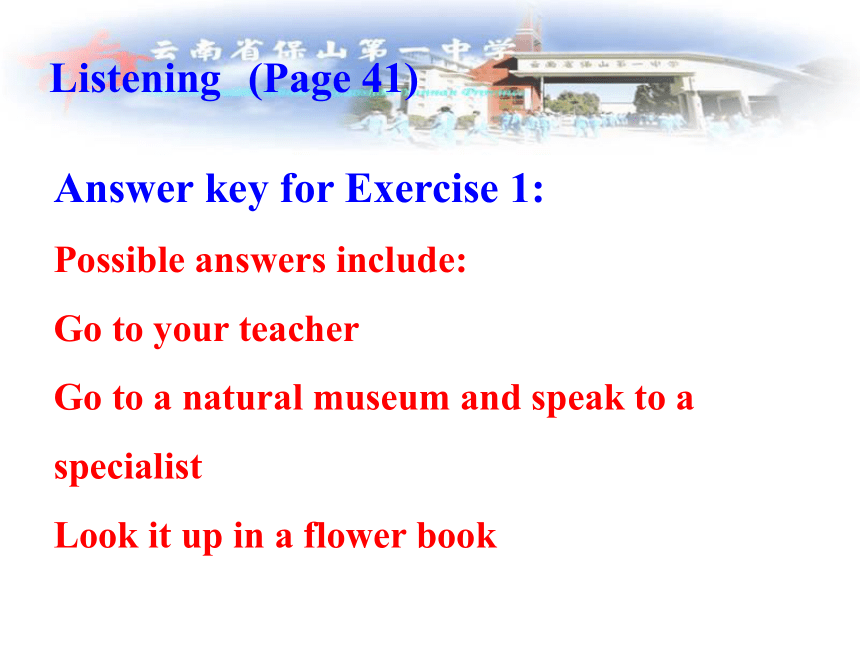
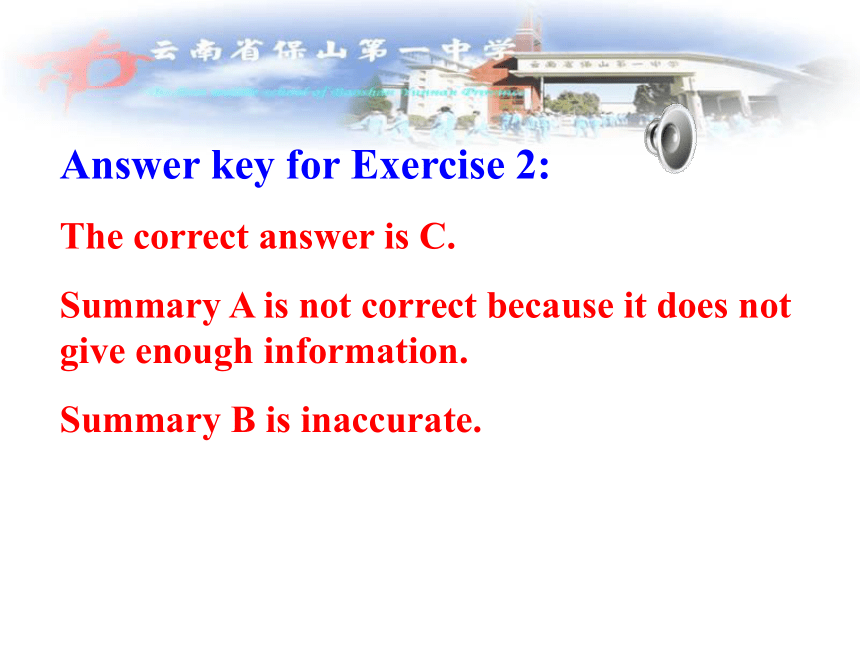
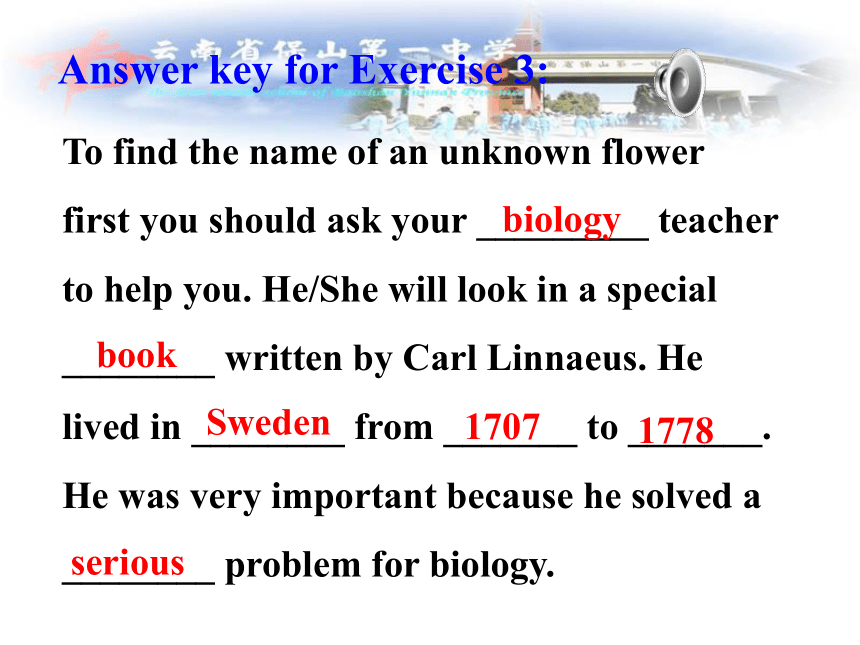
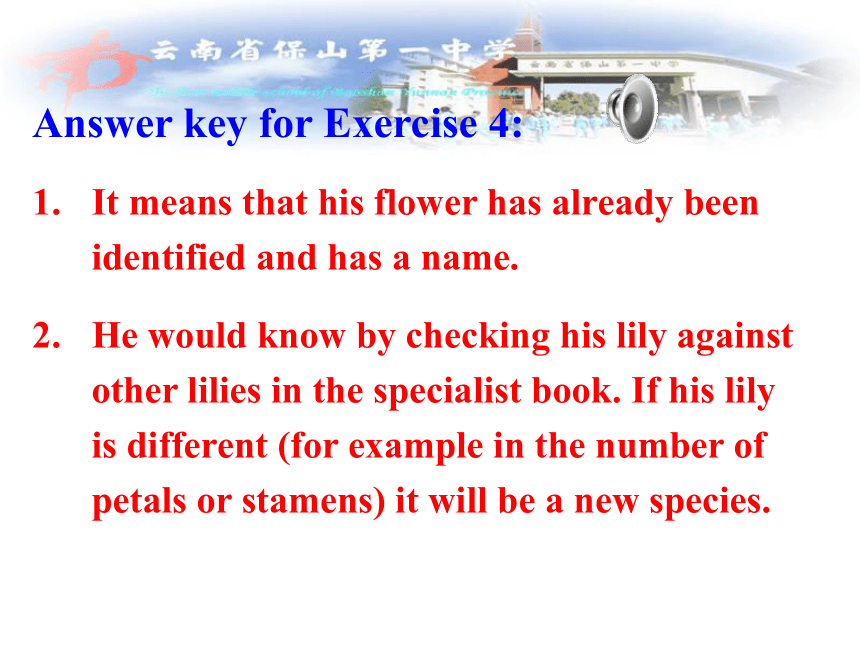

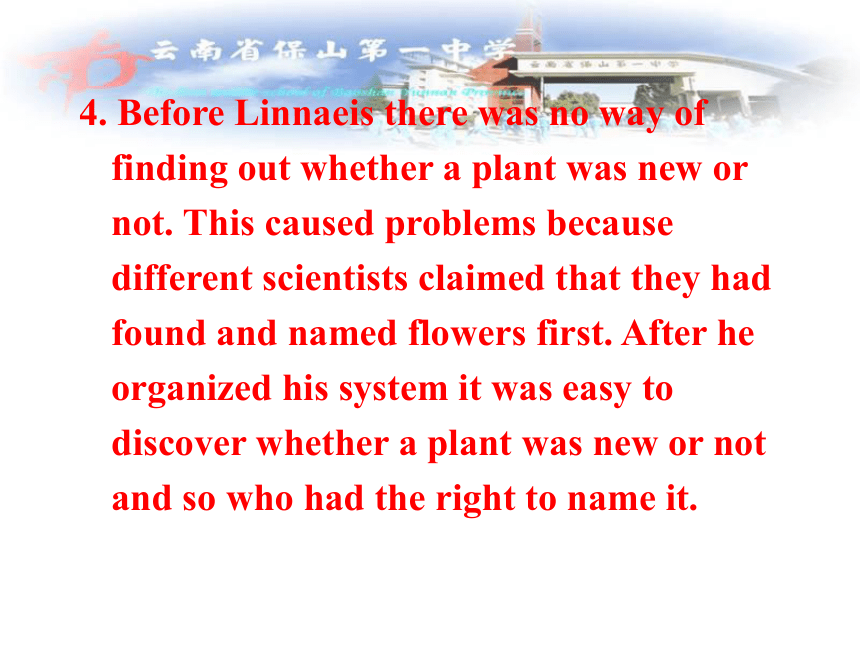
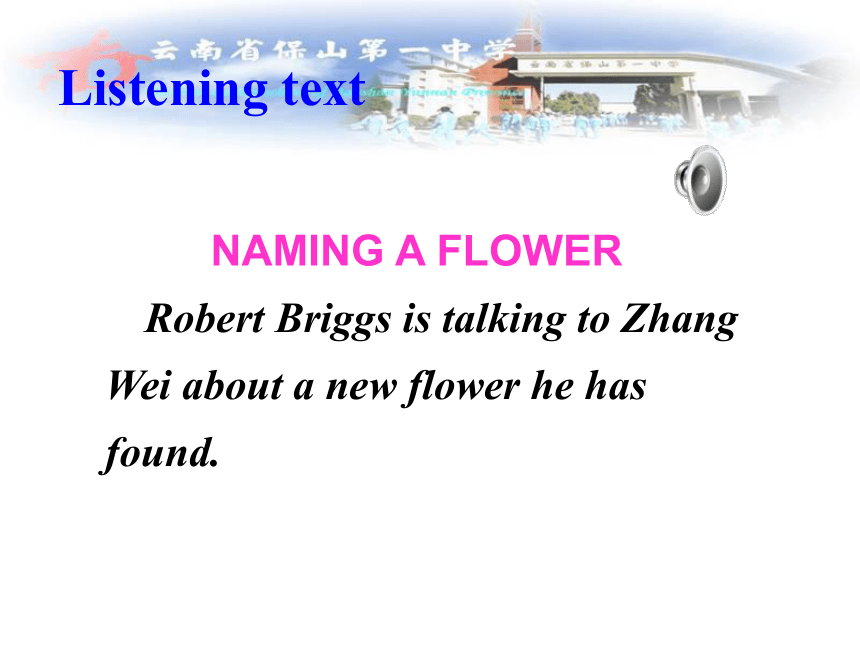
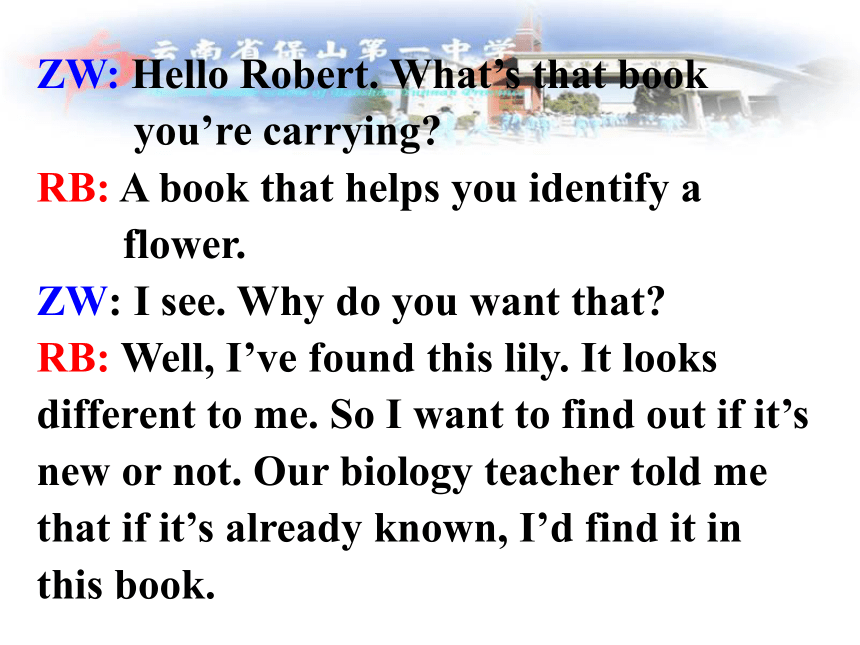
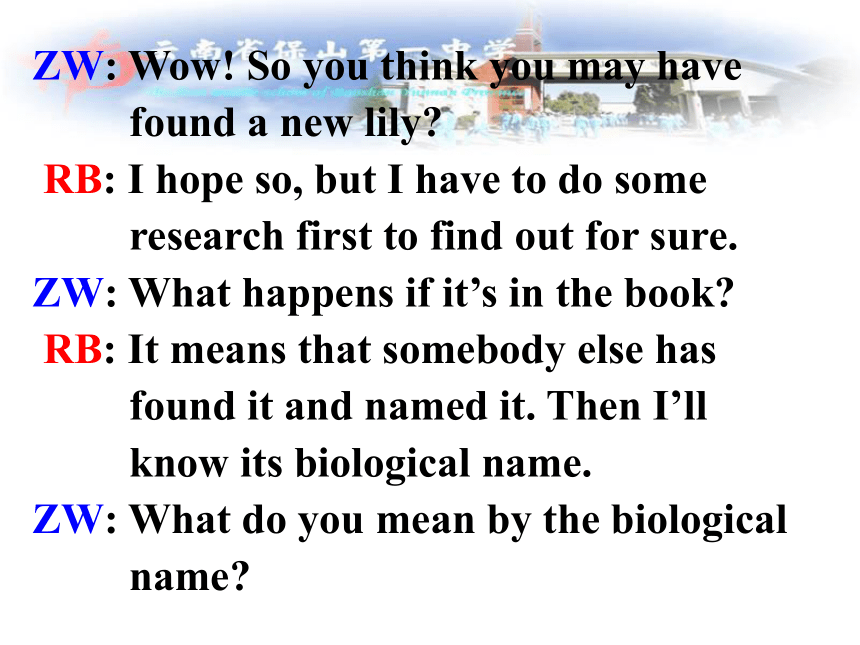
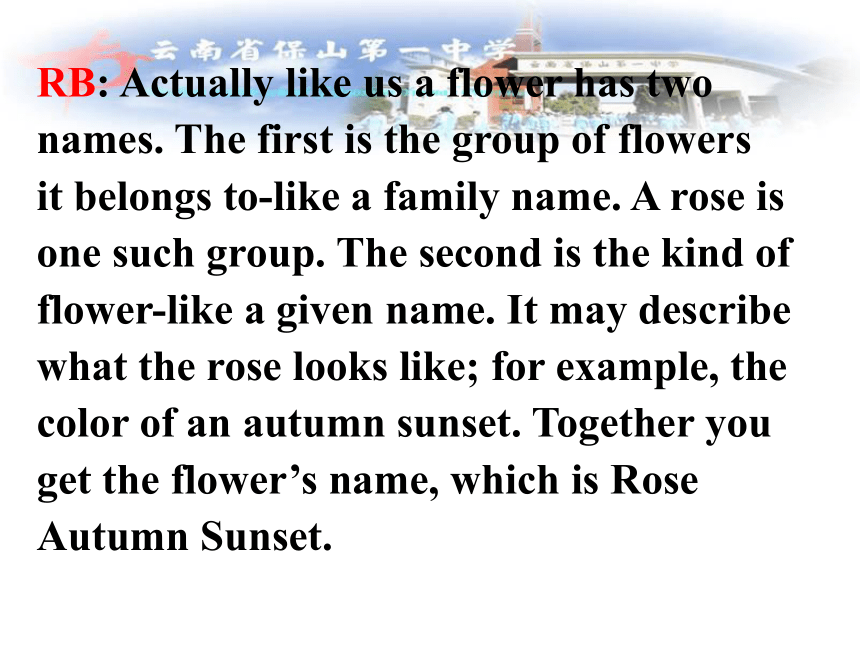
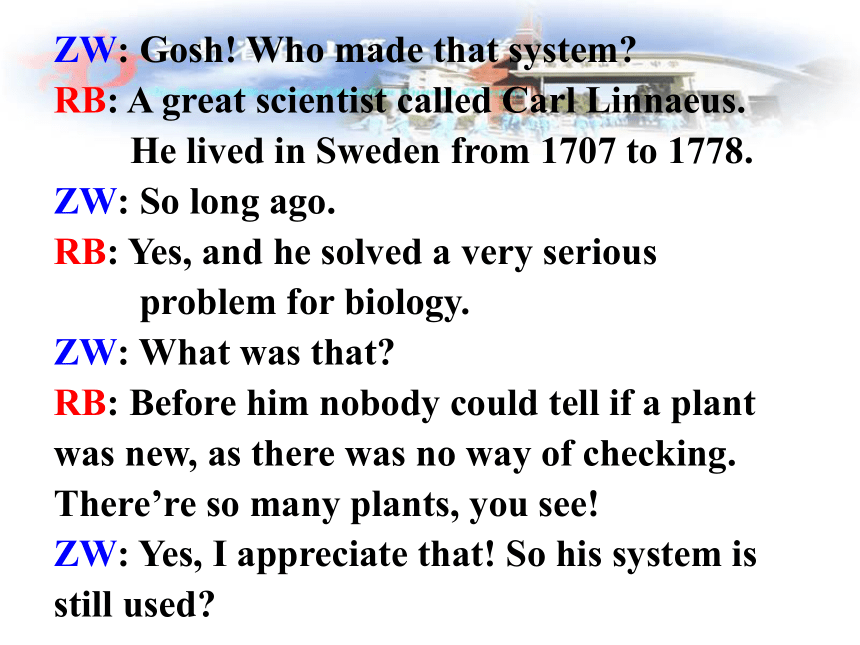
文档简介
课件47张PPT。Unit 1
Great scientists
Workbook Answer key for Exercise 1:
Possible answers include:
Go to your teacher
Go to a natural museum and speak to a
specialist
Look it up in a flower bookListening(Page 41)Answer key for Exercise 2:
The correct answer is C.
Summary A is not correct because it does not give enough information.
Summary B is inaccurate.Answer key for Exercise 3:To find the name of an unknown flower
first you should ask your _________ teacher
to help you. He/She will look in a special
________ written by Carl Linnaeus. He
lived in ________ from _______ to _______.
He was very important because he solved a
________ problem for biology. biology bookSweden 17071778seriousAnswer key for Exercise 4:
It means that his flower has already been identified and has a name.
He would know by checking his lily against other lilies in the specialist book. If his lily is different (for example in the number of petals or stamens) it will be a new species.All plants have two names just like people. The first is the group of flowers they belong to and is like the family name. The second is the kind of flower within that group and is like a given/personal name.4. Before Linnaeis there was no way of finding out whether a plant was new or not. This caused problems because different scientists claimed that they had found and named flowers first. After he organized his system it was easy to discover whether a plant was new or not and so who had the right to name it.NAMING A FLOWER
Robert Briggs is talking to Zhang Wei about a new flower he has found. Listening textZW: Hello Robert. What’s that book
you’re carrying?
RB: A book that helps you identify a
flower.
ZW: I see. Why do you want that?
RB: Well, I’ve found this lily. It looks
different to me. So I want to find out if it’s
new or not. Our biology teacher told me
that if it’s already known, I’d find it in
this book. ZW: Wow! So you think you may have
found a new lily?
RB: I hope so, but I have to do some
research first to find out for sure.
ZW: What happens if it’s in the book?
RB: It means that somebody else has
found it and named it. Then I’ll
know its biological name.
ZW: What do you mean by the biological
name?RB: Actually like us a flower has two
names. The first is the group of flowers
it belongs to-like a family name. A rose is
one such group. The second is the kind of
flower-like a given name. It may describe
what the rose looks like; for example, the
color of an autumn sunset. Together you
get the flower’s name, which is Rose
Autumn Sunset. ZW: Gosh! Who made that system?
RB: A great scientist called Carl Linnaeus.
He lived in Sweden from 1707 to 1778.
ZW: So long ago.
RB: Yes, and he solved a very serious
problem for biology.
ZW: What was that?
RB: Before him nobody could tell if a plant
was new, as there was no way of checking.
There’re so many plants, you see!
ZW: Yes, I appreciate that! So his system is
still used? RB: Indeed it is. If my flower isn’t in this
book, I’ll know that I’ve found a new
kind of lily.
ZW: That’s great! Can I come and help you?
This research sounds fun.
RB: Yes, and if I’m lucky…(fading out)Talking in pairs How will I recognize you?How will I know you?What will you wear?What special features do you have?What do you look like?You can recognize me because …I’m tallshort, fatthin, youngold with…My …looks a bit like …I have largesmall, browngreen eyes with …Listening Task (Page 44) analyse (分析), pure (纯的),
foundations (基础), symbol (符号),
Л(圆周率); sin(正弦),
cosin (余弦), geometry (几何),
calculus (微积分), mechanics (力学),
practical (实用的), topology (拓扑学) Answer key for Exercise 1:
Students will give their own answers
which may vary.Answer key for Exercise 3:
Tick all symbols except angle.Answer key for Exercise 4:Why Euler is considered to be a great mathematicianintroduced many new symbols into maths
wrote more books than anyone before or since
discovered a new branch of mathematicstopologySuggest answers to Exercise 5:
It had a river running through it. The centre of
konigsberg is an island and as it passes the
island the river breaks into two parts. Seven
bridges were built so that the people of the city
could get from one part to another. The people
wondered if you could walk around the city so
that you would cross each bridge only once.Suggested answers to Exercise 6:
There is no Euler path for this figure. Look at Figure 4 in the Reading task.
It is a Euler path for Figure 3. A MATHEMATICIAN'S PROBLEM
John Smith is talking to Zhao Yang about a mathematician who interests him. Listening textPart 1
JS: Did you know that we have been
studying Euler’s work in maths?
ZY: Who is he? I have never heard
of him. JS: Well, he was a famous
mathematician in the eighteenth
century. He revised all the pure
mathematics that was
known in his day.
ZY: That probably wasn’t very much.JS: You’re wrong there. He wrote
more than any other
mathematician before or since.
ZY: Really! Well what did he do?JS: He introduced a lot of symbols into
mathematics such as the symbol
for pi(Л) and the terms sin and
cosin.
ZY: Wow!
JS: And he did half of this work when
he was blind.
ZY: How did he do that?
JS: He told his ideas to some one
else who wrote them down.Part 2
ZY: What were his achievements?
JS: He introduced a new branch of
mathematics called topology.
It helps you understand things by
using diagrams. The subway map
is a good example. It does not tell
you distances but it shows you how
stations connect together.ZY: How did he start topology?
JS: Well, in 1735 he was inspired by a
problem in the city of Konigsberg
where he lived. Look at the map in
your book. Konigsberg had a river
running through it. The centre is an
island. As the river passes the
island, it breaks into two parts. Seven bridges were built over the river.
Euler wondered if you could walk
around the city so that you cross each
bridge only once.
ZY: Let me try that. It sounds quite
simple to me.
JS: Try, but it’s not as easy as it looks. 除了去公园之外, 我的活动范围仅限于
邻近地区。
Apart from going to the park, I limit my
movements to my neighborhoods.
2. 没有足够的证据很难做出结论。
It’s difficult to draw a conclusion without
enough evidence.
3. 这些科学的探寻将有助于我们项目的成功。
These scientific enquires will contribute
to the success of our project.Translation (Page 42) 4. 居斯特夫·埃菲尔对他修建铁塔的计划
满怀热情, 而这座塔使他闻名于世。
Gustave Eiffel was very enthusiastic about
his plan to construct the iron tower, which
made him world famous.
5. 他常提出些不同寻常的计划, 你在加入
之前要慎重对待。
He often puts forward unusual plans. So be
cautious about them before you decide to
join in. 6. 谁是第一个反对“地心说”的人?
Who was the first person to reject the idea
that the earth was the center of the universe?
7. 虽然他的写作没什么意思, 但弗雷德还
是确信自己的作文会得高分。
Although his writing doesn’t make sense,
Fred is positive that his composition will
score a high mark.How to write biography?一、人物简介的写作步骤
1. Birthday and birth place
2. Family background
3. Education
4. Big events in his or her life
( in order of time )
5. EvaluationWriting 二、人物简介写作中常用的词组及句子Birthday and birth place
—was/were born on…in…,
2. Family background —
1) a poor/rich family
2) his (her) family was so poor that…,
3) with the help of his parents,
4) his father was very strict with him…,
5) the son of a poor family,
6) when he was a small boy,
7) as a child, 8) during his (her) childhood,
9) spend his childhood in…
10) live a happy (hard) life
11) a boy of 153. Education——
1) graduate from…department of …
university,
2) When at college, he majored in…,
3) receive a doctor’s degree.
4) get higher education
5) go abroad for further studies4. Big events in his life——
1) be interested in …, 2) work hard at …,
3) devote his lifetime to …,
4) do research about/into…
5) make a big decision
make up one’s mind to do sth.
6) do sth with great determination and
perseverance.
7) be fond of…, 8) be strict in sth.
9) have a …way of doing sth.
10) try one’s best to do sth.11) encourage sb to do sth.
12) fight for, give up one’s life for sb/sth.
13) win a prize in … competition.
14) be good at.
15) make rapid progress in …,
16) set a new world record of …
17) become a member of …
18) study hard. train hard.
19) win a gold medal.
20) work so hard as to improve…
21) have a gift for…5. Evaluation——
1) one of the best (most important) …
2) set sb a good example.
3) a model teacher.
4) be respected by everyone.
5) sing high praise for…speak (think) highly of…
6) his hard work brought him great success.
7) his heroic story spread all over the city.
8) remember sb forever.
9) be honored as … 10) be famous as …,
11) be regarded as …,
12) become a world champion at…
Championships.
13) He became famous for his new theory.
14) The people had come to love him as an
inspiring leader.
15) Lei Feng has been praised for his
communist spirit.
16) People spoke highly of him and all
respected him.6. 高考中描写人常用表达方式
(1)介绍人物的姓名、出身
She was born in Poland on Nov. 7, 1867.
她于1867年11月7日出生于波兰。
a great scientist with the name Einstein
一个叫爱因斯坦的伟大科学家
Abraham Lincoln, the son of a poor family, was born
in Kentucky on February 12, 1809.
亚伯拉汗·林肯, 一个贫苦家庭的儿子, 于1809年2月
12日出生于肯他基州。
Born of a poor clerk’s family, Charles Dickens had
little schooling. 出生在一个贫困的小职员家庭中,
查儿斯·狄更斯没接受多少学校教育。(2) 描述人物外貌和性格特征的常用词语
good-looking 长得好看的
funny-looking 长相滑稽的
ugly-looking 长得难看的
ordinary looking 长相一般的
white-haired 白头发的
warm-hearted 热心肠的
kind–hearted 好心的
absent-minded 心不在焉的
bad-tempered 脾气不好的 near/short - sighted 近视眼的
far-sighted 远视的 tall 个高的 short 个矮的
pretty 漂亮的 naughty 淘气
lovely 可爱的 easy - going 温和宽容的
smart 精明的 wise 明智的
bright 聪明的 diligent 勤奋的
lazy 懒惰的 clever 聪明的
healthy 健康的 humorous 幽默的
funny 滑稽的 silent 沉默的
attractive 有吸引力的 talkative 多话的(3)表达人物兴趣和爱好的常用词组或短语
like … very much 非常喜欢……
love 喜爱
be interested in 对……感兴趣
be fond of 喜欢……
hate 憎恨
be tired of 对……厌倦
be crazy about 对……极度喜欢
enjoy 喜欢……
lose interest in 对……失去兴趣(4) 描述人物心情的常用词语:
sad 难过的 happy 高兴的
excited 兴奋的 pleased 高兴的
satisfied 满意的 angry 生气的
worried 担心的 disappointed 失望的
terrified 恐惧的 friendly 友好的
anxious 焦虑的 curious 好奇的
eager 急切的三、实例分析写一段人物介绍, 介绍少年体育明星孙淑伟。
内容要点如下:
1) 简况: 孙淑伟(Sun Shuwei): 男, 14岁, 广东人
2) 训练项目: 跳水(diving)
3) 取得成绩: 第十一届亚运会冠军, 第六届世界游泳
锦标赛冠军(亚运会: the Asia Games 冠军:
Champion 游泳锦标赛:Swimming Championships)
4) 其他情况: 从小就喜欢游泳, 8岁进广东省跳水队;
在学校里认真学习, 在跳水队时认真训练, 13岁进入
国家队, 一年后(1990)夺得十一届亚运会金牌; 今年
年初获第六届游泳锦标赛冠军。注意: 1) 要有标题。
2) 介绍须包括所有内容要点, 但不要
逐条译成英语。
3) 介绍的长度为80~120个词。 题解:
这是一篇人物报道, 根据所提供的材料组织
文章。首先应确定标题。如: Sun Shuwei –
A World Champion in Diving 其次应介绍
人物的姓名、性别、年龄、籍贯, 随后介绍
他的成长过程, 最后介绍他取得的成就。书面表达范文:
Sun Shuwei - A World Champion in Diving
Sun Shuwei, a world champion in diving, is
a boy of 14 from Guangdong. He loved
swimming when he was a small boy and at eight
he became a member of the diving team in
Guangdong Province. He studied hard at school
and trained hard for five years before he came
to the national team. A year later in 1990, he
won a gold medal at the 11th Asia Games and
became a world champion at the 6th world
Swimming Championships early this years.Homework1. Do exercises of this part on the
workbook.
2. Write a short passage about
Copernicus. Thank You!
Great scientists
Workbook Answer key for Exercise 1:
Possible answers include:
Go to your teacher
Go to a natural museum and speak to a
specialist
Look it up in a flower bookListening(Page 41)Answer key for Exercise 2:
The correct answer is C.
Summary A is not correct because it does not give enough information.
Summary B is inaccurate.Answer key for Exercise 3:To find the name of an unknown flower
first you should ask your _________ teacher
to help you. He/She will look in a special
________ written by Carl Linnaeus. He
lived in ________ from _______ to _______.
He was very important because he solved a
________ problem for biology. biology bookSweden 17071778seriousAnswer key for Exercise 4:
It means that his flower has already been identified and has a name.
He would know by checking his lily against other lilies in the specialist book. If his lily is different (for example in the number of petals or stamens) it will be a new species.All plants have two names just like people. The first is the group of flowers they belong to and is like the family name. The second is the kind of flower within that group and is like a given/personal name.4. Before Linnaeis there was no way of finding out whether a plant was new or not. This caused problems because different scientists claimed that they had found and named flowers first. After he organized his system it was easy to discover whether a plant was new or not and so who had the right to name it.NAMING A FLOWER
Robert Briggs is talking to Zhang Wei about a new flower he has found. Listening textZW: Hello Robert. What’s that book
you’re carrying?
RB: A book that helps you identify a
flower.
ZW: I see. Why do you want that?
RB: Well, I’ve found this lily. It looks
different to me. So I want to find out if it’s
new or not. Our biology teacher told me
that if it’s already known, I’d find it in
this book. ZW: Wow! So you think you may have
found a new lily?
RB: I hope so, but I have to do some
research first to find out for sure.
ZW: What happens if it’s in the book?
RB: It means that somebody else has
found it and named it. Then I’ll
know its biological name.
ZW: What do you mean by the biological
name?RB: Actually like us a flower has two
names. The first is the group of flowers
it belongs to-like a family name. A rose is
one such group. The second is the kind of
flower-like a given name. It may describe
what the rose looks like; for example, the
color of an autumn sunset. Together you
get the flower’s name, which is Rose
Autumn Sunset. ZW: Gosh! Who made that system?
RB: A great scientist called Carl Linnaeus.
He lived in Sweden from 1707 to 1778.
ZW: So long ago.
RB: Yes, and he solved a very serious
problem for biology.
ZW: What was that?
RB: Before him nobody could tell if a plant
was new, as there was no way of checking.
There’re so many plants, you see!
ZW: Yes, I appreciate that! So his system is
still used? RB: Indeed it is. If my flower isn’t in this
book, I’ll know that I’ve found a new
kind of lily.
ZW: That’s great! Can I come and help you?
This research sounds fun.
RB: Yes, and if I’m lucky…(fading out)Talking in pairs How will I recognize you?How will I know you?What will you wear?What special features do you have?What do you look like?You can recognize me because …I’m tallshort, fatthin, youngold with…My …looks a bit like …I have largesmall, browngreen eyes with …Listening Task (Page 44) analyse (分析), pure (纯的),
foundations (基础), symbol (符号),
Л(圆周率); sin(正弦),
cosin (余弦), geometry (几何),
calculus (微积分), mechanics (力学),
practical (实用的), topology (拓扑学) Answer key for Exercise 1:
Students will give their own answers
which may vary.Answer key for Exercise 3:
Tick all symbols except angle.Answer key for Exercise 4:Why Euler is considered to be a great mathematicianintroduced many new symbols into maths
wrote more books than anyone before or since
discovered a new branch of mathematicstopologySuggest answers to Exercise 5:
It had a river running through it. The centre of
konigsberg is an island and as it passes the
island the river breaks into two parts. Seven
bridges were built so that the people of the city
could get from one part to another. The people
wondered if you could walk around the city so
that you would cross each bridge only once.Suggested answers to Exercise 6:
There is no Euler path for this figure. Look at Figure 4 in the Reading task.
It is a Euler path for Figure 3. A MATHEMATICIAN'S PROBLEM
John Smith is talking to Zhao Yang about a mathematician who interests him. Listening textPart 1
JS: Did you know that we have been
studying Euler’s work in maths?
ZY: Who is he? I have never heard
of him. JS: Well, he was a famous
mathematician in the eighteenth
century. He revised all the pure
mathematics that was
known in his day.
ZY: That probably wasn’t very much.JS: You’re wrong there. He wrote
more than any other
mathematician before or since.
ZY: Really! Well what did he do?JS: He introduced a lot of symbols into
mathematics such as the symbol
for pi(Л) and the terms sin and
cosin.
ZY: Wow!
JS: And he did half of this work when
he was blind.
ZY: How did he do that?
JS: He told his ideas to some one
else who wrote them down.Part 2
ZY: What were his achievements?
JS: He introduced a new branch of
mathematics called topology.
It helps you understand things by
using diagrams. The subway map
is a good example. It does not tell
you distances but it shows you how
stations connect together.ZY: How did he start topology?
JS: Well, in 1735 he was inspired by a
problem in the city of Konigsberg
where he lived. Look at the map in
your book. Konigsberg had a river
running through it. The centre is an
island. As the river passes the
island, it breaks into two parts. Seven bridges were built over the river.
Euler wondered if you could walk
around the city so that you cross each
bridge only once.
ZY: Let me try that. It sounds quite
simple to me.
JS: Try, but it’s not as easy as it looks. 除了去公园之外, 我的活动范围仅限于
邻近地区。
Apart from going to the park, I limit my
movements to my neighborhoods.
2. 没有足够的证据很难做出结论。
It’s difficult to draw a conclusion without
enough evidence.
3. 这些科学的探寻将有助于我们项目的成功。
These scientific enquires will contribute
to the success of our project.Translation (Page 42) 4. 居斯特夫·埃菲尔对他修建铁塔的计划
满怀热情, 而这座塔使他闻名于世。
Gustave Eiffel was very enthusiastic about
his plan to construct the iron tower, which
made him world famous.
5. 他常提出些不同寻常的计划, 你在加入
之前要慎重对待。
He often puts forward unusual plans. So be
cautious about them before you decide to
join in. 6. 谁是第一个反对“地心说”的人?
Who was the first person to reject the idea
that the earth was the center of the universe?
7. 虽然他的写作没什么意思, 但弗雷德还
是确信自己的作文会得高分。
Although his writing doesn’t make sense,
Fred is positive that his composition will
score a high mark.How to write biography?一、人物简介的写作步骤
1. Birthday and birth place
2. Family background
3. Education
4. Big events in his or her life
( in order of time )
5. EvaluationWriting 二、人物简介写作中常用的词组及句子Birthday and birth place
—was/were born on…in…,
2. Family background —
1) a poor/rich family
2) his (her) family was so poor that…,
3) with the help of his parents,
4) his father was very strict with him…,
5) the son of a poor family,
6) when he was a small boy,
7) as a child, 8) during his (her) childhood,
9) spend his childhood in…
10) live a happy (hard) life
11) a boy of 153. Education——
1) graduate from…department of …
university,
2) When at college, he majored in…,
3) receive a doctor’s degree.
4) get higher education
5) go abroad for further studies4. Big events in his life——
1) be interested in …, 2) work hard at …,
3) devote his lifetime to …,
4) do research about/into…
5) make a big decision
make up one’s mind to do sth.
6) do sth with great determination and
perseverance.
7) be fond of…, 8) be strict in sth.
9) have a …way of doing sth.
10) try one’s best to do sth.11) encourage sb to do sth.
12) fight for, give up one’s life for sb/sth.
13) win a prize in … competition.
14) be good at.
15) make rapid progress in …,
16) set a new world record of …
17) become a member of …
18) study hard. train hard.
19) win a gold medal.
20) work so hard as to improve…
21) have a gift for…5. Evaluation——
1) one of the best (most important) …
2) set sb a good example.
3) a model teacher.
4) be respected by everyone.
5) sing high praise for…speak (think) highly of…
6) his hard work brought him great success.
7) his heroic story spread all over the city.
8) remember sb forever.
9) be honored as … 10) be famous as …,
11) be regarded as …,
12) become a world champion at…
Championships.
13) He became famous for his new theory.
14) The people had come to love him as an
inspiring leader.
15) Lei Feng has been praised for his
communist spirit.
16) People spoke highly of him and all
respected him.6. 高考中描写人常用表达方式
(1)介绍人物的姓名、出身
She was born in Poland on Nov. 7, 1867.
她于1867年11月7日出生于波兰。
a great scientist with the name Einstein
一个叫爱因斯坦的伟大科学家
Abraham Lincoln, the son of a poor family, was born
in Kentucky on February 12, 1809.
亚伯拉汗·林肯, 一个贫苦家庭的儿子, 于1809年2月
12日出生于肯他基州。
Born of a poor clerk’s family, Charles Dickens had
little schooling. 出生在一个贫困的小职员家庭中,
查儿斯·狄更斯没接受多少学校教育。(2) 描述人物外貌和性格特征的常用词语
good-looking 长得好看的
funny-looking 长相滑稽的
ugly-looking 长得难看的
ordinary looking 长相一般的
white-haired 白头发的
warm-hearted 热心肠的
kind–hearted 好心的
absent-minded 心不在焉的
bad-tempered 脾气不好的 near/short - sighted 近视眼的
far-sighted 远视的 tall 个高的 short 个矮的
pretty 漂亮的 naughty 淘气
lovely 可爱的 easy - going 温和宽容的
smart 精明的 wise 明智的
bright 聪明的 diligent 勤奋的
lazy 懒惰的 clever 聪明的
healthy 健康的 humorous 幽默的
funny 滑稽的 silent 沉默的
attractive 有吸引力的 talkative 多话的(3)表达人物兴趣和爱好的常用词组或短语
like … very much 非常喜欢……
love 喜爱
be interested in 对……感兴趣
be fond of 喜欢……
hate 憎恨
be tired of 对……厌倦
be crazy about 对……极度喜欢
enjoy 喜欢……
lose interest in 对……失去兴趣(4) 描述人物心情的常用词语:
sad 难过的 happy 高兴的
excited 兴奋的 pleased 高兴的
satisfied 满意的 angry 生气的
worried 担心的 disappointed 失望的
terrified 恐惧的 friendly 友好的
anxious 焦虑的 curious 好奇的
eager 急切的三、实例分析写一段人物介绍, 介绍少年体育明星孙淑伟。
内容要点如下:
1) 简况: 孙淑伟(Sun Shuwei): 男, 14岁, 广东人
2) 训练项目: 跳水(diving)
3) 取得成绩: 第十一届亚运会冠军, 第六届世界游泳
锦标赛冠军(亚运会: the Asia Games 冠军:
Champion 游泳锦标赛:Swimming Championships)
4) 其他情况: 从小就喜欢游泳, 8岁进广东省跳水队;
在学校里认真学习, 在跳水队时认真训练, 13岁进入
国家队, 一年后(1990)夺得十一届亚运会金牌; 今年
年初获第六届游泳锦标赛冠军。注意: 1) 要有标题。
2) 介绍须包括所有内容要点, 但不要
逐条译成英语。
3) 介绍的长度为80~120个词。 题解:
这是一篇人物报道, 根据所提供的材料组织
文章。首先应确定标题。如: Sun Shuwei –
A World Champion in Diving 其次应介绍
人物的姓名、性别、年龄、籍贯, 随后介绍
他的成长过程, 最后介绍他取得的成就。书面表达范文:
Sun Shuwei - A World Champion in Diving
Sun Shuwei, a world champion in diving, is
a boy of 14 from Guangdong. He loved
swimming when he was a small boy and at eight
he became a member of the diving team in
Guangdong Province. He studied hard at school
and trained hard for five years before he came
to the national team. A year later in 1990, he
won a gold medal at the 11th Asia Games and
became a world champion at the 6th world
Swimming Championships early this years.Homework1. Do exercises of this part on the
workbook.
2. Write a short passage about
Copernicus. Thank You!
